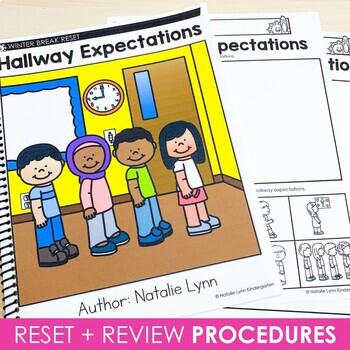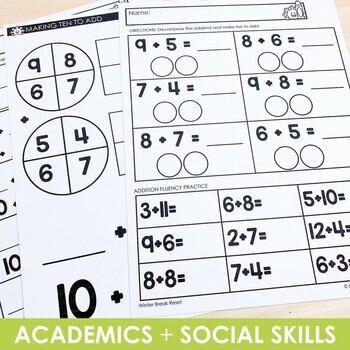First Grade Winter Break Reset Week After Winter Break Lesson Plans Review
- Zip
What educators are saying
Description
Do you feel like your 1st grade class needs a reset button after winter break? Take the stress of planning for the week after winter break off of your plate, while feeling confident that you're reviewing all the important procedures and routines.
The First Grade Winter Break Reset is an all-in-one unit that will plan out your ENTIRE week after winter break for you!
What's included in this unit?
The 1st Grade Winter Break Reset includes 5 days of lesson plans for:
- Morning meeting
- Shared reading poem
- Literacy Interactive Read Alouds
- Phonics
- Winter Break Reset - Reviewing Supplies
- Winter Break Reset - Reviewing Procedures and Routines
- Writing
- Grammar
- Math
- Social Studies
Why do you need the First Grade Winter Break Reset? How good would it feel to know that your entire first week back from winter break is planned and ready to go? You can rest easy knowing that you'll be reviewing all important procedures and routines, getting a refresh in classroom rules and expectations, and starting the new year strong in academics.
If you were a fan of the First Week of First Grade unit, you'll love the 1st grade Winter Break Reset!
Take a look at the lessons:
LITERACY
The whole group literacy time will use the Interactive Read Aloud model as you read the same text all week. Each day you will focus on:
- Story elements
- Character traits
- Vocabulary
- Retelling beginning, middle, end
- Making connections
PHONICS
The phonics lessons will review short and long vowel sounds, digraphs, and blending CCVC words with beginning blends.
- Monday: digraph sh
- Tuesday: digraph ch
- Wednesday: digraph th
- Thuesday: digraph wh
- Friday: digraph ck
WRITING
These writing mini lessons will review narrative writing.
- Narrative writing review
- Stories need a setting
- Using descriptive verbs
- Characters have feelings
- Editing our writing
MATH
For math, you will focus on place value with teen numbers and addition and subtraction strategies to 20.
- Teen numbers are a group of ten and some extra ones
- Addition to 20: counting on
- Addition to 20: making ten to add
- Subtraction to 20: counting back
- Subtraction to 20: missing addends
WINTER BREAK RESET
There are two winter break reset times each day. The first will focus on using supplies, while the second focuses on classroom procedures and routines.
- Monday: Using crayons and hallway expectations
- Tuesday: Using scissors and glue and lining up
- Wednesday: Using markers and centers routine
- Thursday: Caring for books and centers routine
- Friday: Listening and centers routine
SOCIAL STUDIES
The social studies time will focus more on classroom rules and expectations. This will meet the social studies standards focusing on citizenship.
- Classroom routines
- Hallway expectations
- Classroom choices at school
- Recess safety in the winter
- Growth mindset and setting goals
- *Bathroom expectations is included as an extra
INCLUDES 8 NO PREP CENTERS!
First Grade literacy center mats:
- Magnetic Letter Building - digraphs, blends, or cvce words
- Spin, Build, Cover - digraphs, blends, or cvce words
- Cover by Code
- Spin and Cover
First Grade math center mats:
- Spin and Add
- Spin and Cover Addition and Subtraction
- Cover by Code Shapes or Addition
- Snowball Fight Addition
What else is included?
- Winter morning greetings
- Winter deep breathing exercises
- Winter Weather winter poem for shared reading
- Winter poem visualizing
- Winter poem student reader
- New Year Resolutions craft and bulletin board display
- Vowel Flash cards
- Blend It cards
- At the Carpet expectations poster
- Hallway expectations poster
- Listening expectations poster
- Listen and Laugh activity
- Student math mats no prep games
- Writing paper options
- Parts of a sentence posters
- 6 social stories books about classroom expectations and safety
- Student worksheets
- 8no prep First grade math and literacy centers mats
FREQUENTLY ASKED QUESTIONS:
Will this unit work for other grade levels? The Winter Break Reset was designed with First grade standards in mind.
Will this unit require a lot of prep?
Most of this unit is print and go for you. There are a few activities that will require you to gather supplies or do minimal cutting. The social studies books included can be bound, but they can also be displayed digitally for a no prep option.
When will the First Grade Winter Break Reset work best? This unit was designed for the week after winter break, however, it could also be used anytime in the winter for a refresher.





